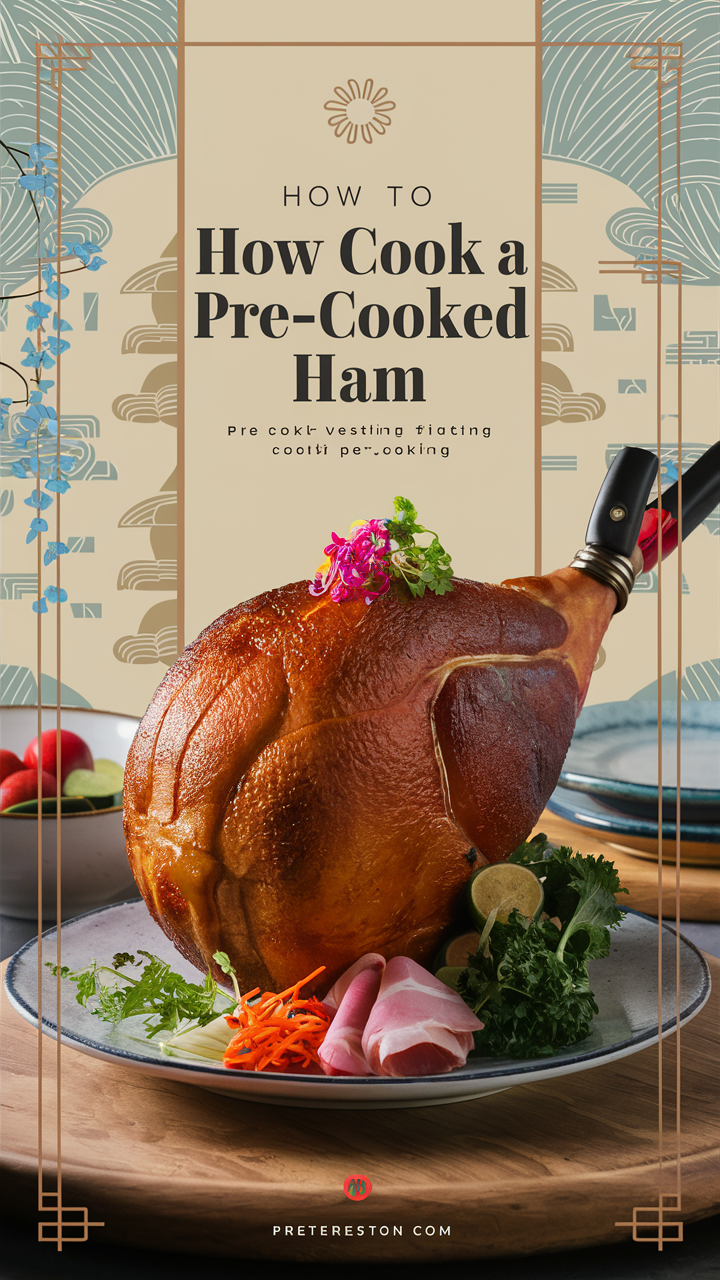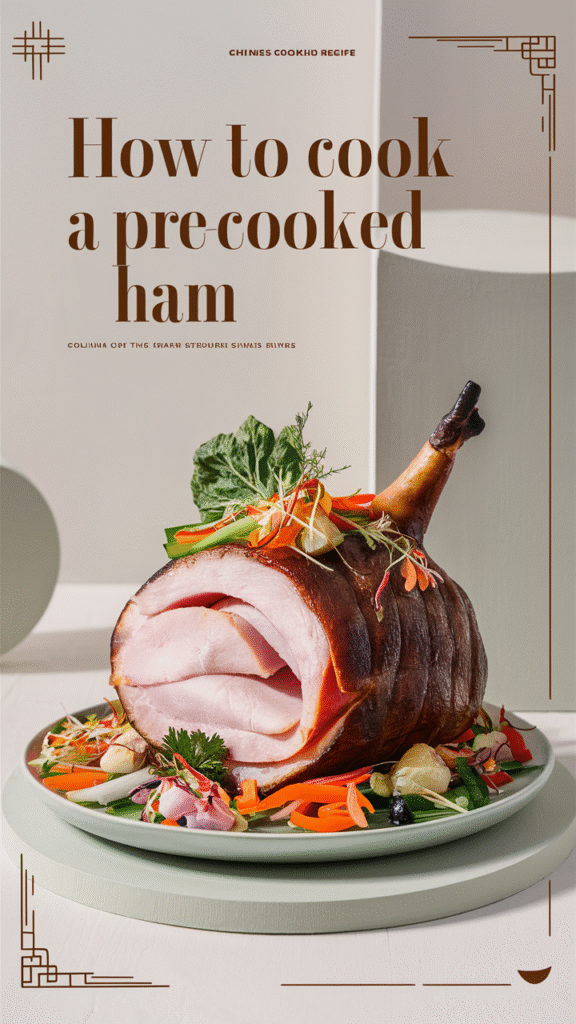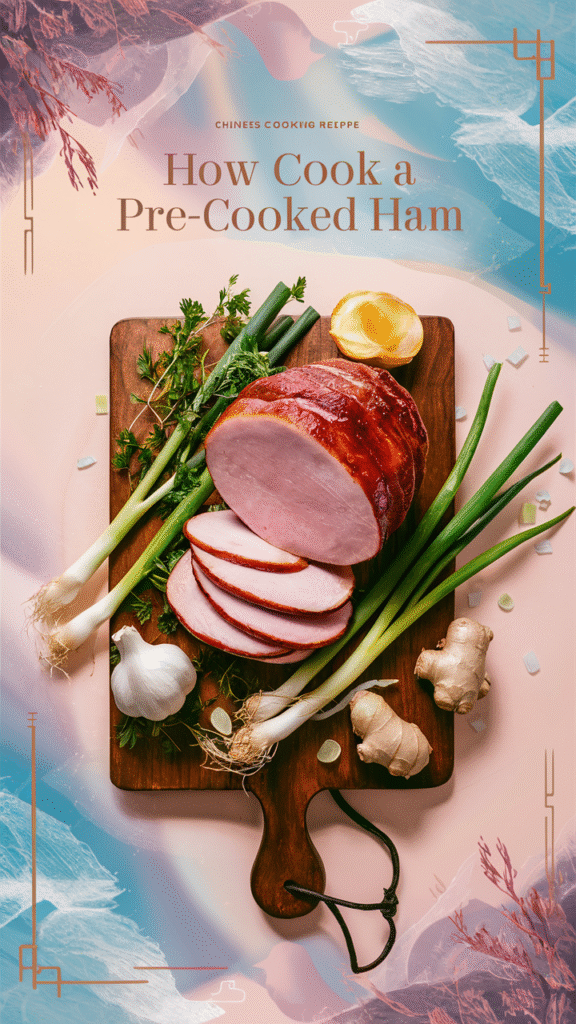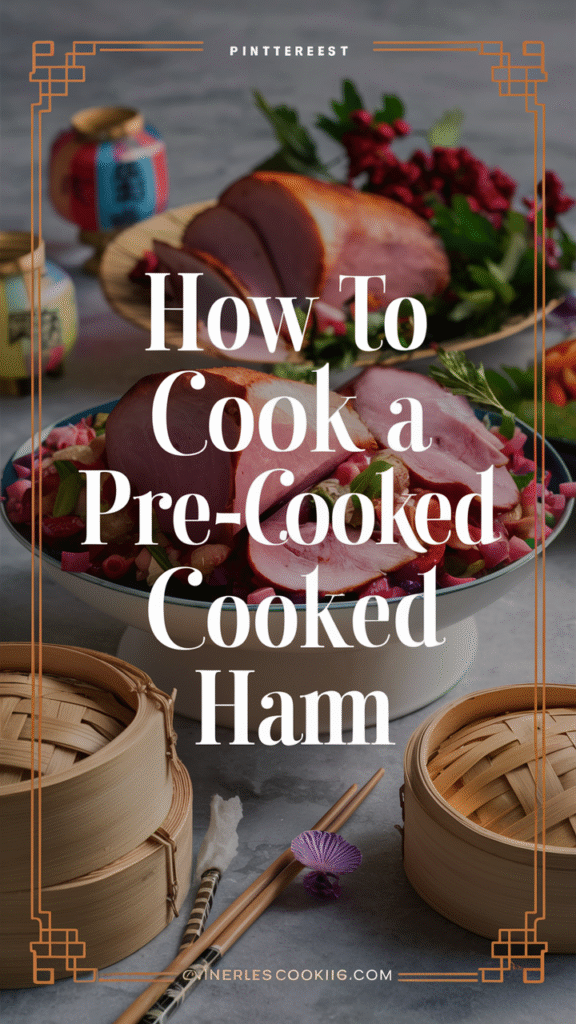Cooking a pre-cooked ham can be an enjoyable and rewarding experience, allowing you to serve a delicious centerpiece for your meal without starting from scratch. With the right techniques, you can ensure that your ham is flavorful, moist, and perfectly heated. Let’s explore some effective methods to achieve this goal.
Choosing the Right Pre-Cooked Ham
Before you begin cooking, it’s essential to select the right kind of pre-cooked ham. Hams vary in flavor, texture, and preparation methods. Here are some common types:
- Bone-In Ham: This type often offers more flavor and moisture due to the bone.
- Boneless Ham: Easier to carve, boneless ham is a popular choice for its convenience.
- Spiral-Cut Ham: Pre-sliced ham that allows for easy serving and great presentation.
Preparation Steps
To ensure your pre-cooked ham turns out perfectly, follow these steps:
- Preheat Your Oven: Start by preheating your oven to 325°F (165°C).
- Prepare the Ham: Remove the ham from its packaging and discard any plastic or netting. Place the ham in a roasting pan, cut side down, to keep it moist.
- Add Liquid: To enhance flavor and moisture, add water, broth, or apple juice to the bottom of the pan. This will create steam while cooking.
- Cover the Ham: Use aluminum foil to cover the ham loosely, trapping moisture during cooking.
Cooking Time and Temperature
The cooking time for pre-cooked ham varies based on its weight. As a general rule, allow about 10-15 minutes per pound. Here’s a simple table to help:
| Weight of Ham (lbs) | Cooking Time (mins) |
|---|---|
| 5 | 50-75 |
| 8 | 80-120 |
| 10 | 100-150 |
| 12 | 120-180 |
Check for an internal temperature of at least 140°F (60°C). Use a meat thermometer for the most accurate reading, and insert it into the thickest part of the ham without touching the bone.
Glazing Your Ham
A glaze can add flavor and create a beautiful caramelized finish on your ham. Here’s how to prepare a simple glaze:
- Ingredients: Combine brown sugar, honey, mustard, and black pepper in a bowl. You can also add fruit preserves for sweetness.
- Apply the Glaze: In the last 30 minutes of cooking, remove the foil and brush a generous amount of glaze over the ham.
- Return to Oven: Continue to cook uncovered, allowing the glaze to caramelize.
Serving Suggestions
Once your ham is perfectly cooked, let it rest for about 15 minutes before slicing. This allows the juices to redistribute, ensuring moist slices. Here are some ideas for serving:
- Pair with sides like mashed potatoes, green beans, or a fresh salad.
- Serve with different mustards or sauces on the side for an extra kick.
- Utilize leftovers in sandwiches, soups, or casseroles.
Remember, the key to a delightful pre-cooked ham lies in gentle reheating and creative flavors. For more tips and recipes, you can visit Food Network or AllRecipes. These resources provide great ideas to elevate your cooking skills and make your ham experience even more enjoyable.
By following these techniques, you can make your pre-cooked ham a stunning success on the dinner table. Enjoy the process and savor the results!
Flavor Enhancements: Glazes and Seasonings for Ham
Cooking a pre-cooked ham is a fantastic way to elevate your meal, but the flavor doesn’t end with just heating it up. Enhancements like glazes and seasonings can turn an ordinary ham into a culinary masterpiece. Here’s a guide to some flavorful options that will make your ham absolutely delicious.
Before diving into specific glazes and seasonings, it’s crucial to understand what a pre-cooked ham is. Typically, these hams are fully cooked during processing, which saves you time and effort. What you need to focus on is adding layers of flavor during the reheating process.
Popular Glaze Types
Glazes are typically sweet or savory coatings that add moisture and flavor to your ham. Here are a few popular types to consider:
- Brown Sugar Glaze: Combining brown sugar, mustard, and vinegar creates a sweet yet tangy flavor that caramelizes beautifully in the oven.
- Pineapple Glaze: A blend of crushed pineapples, brown sugar, and maraschino cherries adds a tropical note that is both sweet and citrusy.
- Honey Mustard Glaze: Mixing honey with Dijon mustard results in a sweet and slightly spicy glaze that complements the smoky flavor of the ham.
- Maple Glaze: Using pure maple syrup with garlic and soy sauce brings a delightful sweet and savory balance that enhances the ham’s natural flavor.
Creating Your Own Glazes
If you want to customize your ham’s flavor, consider experimenting with your glazes:
- Start with a base like brown sugar or honey.
- Add acidity with vinegar or citrus juice for balance.
- Incorporate spices such as cloves, cinnamon, or ginger to bring warmth and depth.
- For a savory kick, add mustard, garlic, or herbs.
Mix these ingredients in a saucepan, bringing them to a gentle boil until thickened. Brush your homemade glaze over the ham during the last 30 minutes of cooking to allow flavors to meld.
Seasoning Options
In addition to glazes, diverse seasonings can enhance your pre-cooked ham:
| Seasoning | Flavor Profile | Application |
|---|---|---|
| Pepper | Spicy and sharp | Coat the ham before baking |
| Garlic Powder | Savory and aromatic | Mix into glaze or rub |
| Mustard Powder | Tangy and sharp | Combine with brown sugar for glaze |
| Cinnamon | Warm and sweet | Sprinkle on the surface before cooking |
These seasonings can be used individually or combined for a more complex flavor. Apply them evenly across the surface of the ham to ensure every bite is flavorful.
Cooking Tips for Flavor Enhancement
When preparing your pre-cooked ham, keep these tips in mind for the best results:
- Score the Ham: Lightly scoring the fat on the surface allows the glaze to seep into the meat for deeper flavor.
- Use a Meat Thermometer: To ensure optimal flavor and texture, cook your ham to an internal temperature of 140°F.
- Let it Rest: After removing the ham from the oven, let it rest for about 10 minutes before slicing. This seals in the juices and enhances moistness.
- Revenant Glaze: Save any extra glaze to brush on the slices as you serve them, ensuring each piece is bursting with flavor.
For more ideas and detailed recipes, websites such as Food Network and Allrecipes offer ample inspiration. Remember, the right glaze or seasoning can turn your pre-cooked ham into a centerpiece that everyone will rave about. With a little creativity and preparation, you can serve up a dish that’s not only simple to prepare but full of amazing flavors.
Common Mistakes to Avoid When Reheating Ham
Reheating ham can sometimes feel daunting, especially if you want to maintain its taste and texture. However, common mistakes can make the dish dry or leave it tasting less than delicious. To help you enjoy your ham at its best, here are some pitfalls to avoid when reheating.
Not Thawing Properly
One of the first mistakes people make is not thawing frozen ham correctly. If you’re dealing with a frozen ham, avoid placing it in the microwave to expedite the process. Instead, thaw it safely in the refrigerator the day before you plan to reheat it. This ensures the ham thaws evenly and reduces the risk of bacteria growth.
Skipping the Glaze
When reheating ham, don’t skip out on the glaze. Applying a sweet or savory glaze can significantly enhance the flavor and moisture of the ham. Popular choices include honey, brown sugar, or a mix of mustard and orange juice. Brush some glaze onto the ham before reheating. This not only adds flavor but also helps to keep the ham juicy as it warms.
Using High Heat
Reheating ham on high heat is a surefire way to dry it out. Instead of rushing the process, opt for a lower heat setting. For instance, preheat your oven to 325°F (165°C) and cover your ham with foil. This helps to trap steam and keeps the ham moist as it heats. Depending on the size of the ham, it may take anywhere from 10 to 15 minutes per pound to fully reheat.
Not Using a Thermometer
Another common error is not checking the internal temperature of the ham. Use a meat thermometer to ensure it reaches an internal temperature of 140°F (60°C). This not only guarantees that the ham is safe to eat but also ensures it’s heated through without overcooking.
Reheating Alone
It may seem easier to just pop the ham in the oven and walk away, but actively checking on it is important. Reheating needs your attention. Regularly check the moisture level in the pan and add broth or water as needed to keep the environment humid. This helps to prevent it from drying out.
Forgetting to Slice Before Reheating
If you have a large piece of ham, consider slicing it before reheating. Sliced ham heats more evenly and quickly, reducing the chances of outer layers being overcooked while the center remains cold. Small chunks or slices can also soak up more glaze and moisture, making for a more flavorful dish.
Overlooking Leftovers Storage
After reheating, pay attention to how you store leftovers. Allow the ham to cool before placing it in airtight containers. Make sure it cools at room temperature for no longer than two hours before refrigerating. This practice helps maintain the quality of your ham for future meals.
| Mistake | Result | Solution |
|---|---|---|
| Not thawing properly | Uneven heating, risk of bacteria | Thaw in the refrigerator |
| Skipping glaze | Dull flavor | Apply a sweet or savory glaze |
| Using high heat | Dry and chewy ham | Reheat at low heat (325°F) |
| Not using a thermometer | Inconsistent temperature | Check for 140°F internal temperature |
| Reheating alone | Dried-out ham | Monitor moisture levels |
| Forgetting to slice | Uneven reheating | Slice before reheating |
| Overlooking storage | Spoiled leftovers | Store in airtight containers |
By being mindful of these common mistakes, you can ensure that your reheated ham is moist, flavorful, and enjoyable. For further tips and recipes, check out resources from Food Network or Allrecipes.
Remember, the key to reheating ham successfully lies in patience, attention, and a little bit of love towards the cooking process. Enjoy your delicious ham without the stress!
Serving Suggestions: Pairing Pre-Cooked Ham with Sides
When you prepare a pre-cooked ham, you have a fantastic centerpiece for your meal that can be both delicious and versatile. Pairing this savory dish with the right sides can elevate your dining experience and please a variety of palates. Here are some serving suggestions to help you create the perfect spread alongside your pre-cooked ham.
Classic Sides for Pre-Cooked Ham
Some traditional side dishes are a natural match for ham. Their flavors complement the rich and savory notes of the meat:
- Scalloped Potatoes: These creamy, cheesy layers of potato provide a rich texture that pairs perfectly with ham.
- Green Beans Almondine: The crunch of almonds and the freshness of green beans add a lovely contrast to the ham’s flavor.
- Glazed Carrots: Sweet, tender carrots glazed with brown sugar or honey harmonize beautifully with ham.
- Creamed Spinach: This dish brings a decadent creaminess that balances the savory aspects of the ham.
Vegetable Options
Vegetables into your meal adds not only color but also nutrition. Here are some vegetable side ideas:
- Roasted Brussels Sprouts: These are nutrient-packed and can be caramelized for added sweetness.
- Asparagus with Lemon Zest: Lightly sautéed or steamed asparagus with a hint of lemon makes for a refreshing contrast.
- Mixed Green Salad: A simple salad with a tangy vinaigrette can help to cleanse the palate between bites of the savory ham.
Starchy Pairings
Complementing your ham with a variety of starches enhances the overall satisfaction of the meal:
- Mashed Potatoes: Fluffy mashed potatoes with butter or gravy are always a crowd-pleaser and pair wonderfully with ham.
- Sweet Potato Casserole: The sweetness of the casserole contrasts nicely with the saltiness of the ham, creating a delightful balance.
- Rice Pilaf: A light and herby rice pilaf can absorb some of the flavors from the ham.
Fruity Accents
Add some sweetness and acidity to your plate with fruit-based sides:
- Pineapple Glaze: A grilled or roasted pineapple glaze over your ham can be a sensational flavor combo.
- Apple Sauce: This classic accompaniment offers a sweet, tangy balance that is always welcomed.
- Cranberry Chutney: This can add a gourmet touch to your meal, providing a burst of flavor.
Breads for the Table
Don’t forget about bread! The right bread can complement your ham perfectly:
- Honey Butter Biscuits: These soft, flaky biscuits with a hint of sweetness are simply irresistible.
- Cornbread: A slightly sweet, crumbly cornbread goes wonderfully with ham and is a classic Southern side.
- Sourdough Bread: The tartness of sourdough can enhance the flavor of your ham and offer a satisfying texture.
Final Tips
When serving pre-cooked ham with sides, presentation matters. Arrange your dishes on a large platter or serve them in colorful bowls to create an inviting table. Here are a few pointers:
- Use seasonal vegetables for freshness and flavor.
- Consider dietary restrictions and preferences of your guests when selecting sides.
- Keep the flavors balanced – combine rich, hearty foods with lighter options.
With these serving suggestions, your pre-cooked ham will shine on the dining table. For more information and recipes, check out [Taste of Home](https://www.tasteofhome.com/) and [Food Network](https://www.foodnetwork.com/), which offer a plethora of ideas that inspire your next meal.
Creating a complete and delicious meal is about balance. By carefully selecting your sides, you will create a festive atmosphere and ensure that your dining experience is one that everyone will savor.
Creative Leftover Ideas: Transforming Ham into New Meals
Leftover ham can be a wonderful ingredient, allowing you to create new and exciting meals with minimal effort. When you learn how to transform your leftovers, you not only reduce food waste but also enjoy delicious dishes that delight your taste buds. Here are some creative ideas to turn that leftover ham into fabulous meals.
Ham and Cheese Breakfast Casserole
Start your day off right with a hearty breakfast casserole. Combine diced leftover ham, eggs, shredded cheese, and cubed bread in a baking dish. Season with herbs like thyme and parsley, pour a mixture of milk and beaten eggs over the top, and bake until golden and fully set. This dish is great for brunch with friends or a family meal.
Ham and Bean Soup
This classic dish is a perfect way to use leftover ham. Simply sauté onions, carrots, and celery until tender, then add chopped ham, canned beans, and broth. Let it simmer to let the flavors meld together. It’s warming, filling, and great for cold weather. You could also try adding additional spices or vegetables to personalize it to your taste.
Ham Fried Rice
A quick stir-fry with leftover ham can make a delicious and satisfying meal. Use day-old rice for the best texture. Sauté vegetables like peas, carrots, and onions in a pan, then add the ham and rice. Drizzle with soy sauce for flavor, and finish with green onions. This dish is not only tasty but also a great way to use up that rice sitting in your fridge.
Ham and Pineapple Pizza
If you’re looking for a fun way to repurpose ham, try making homemade pizza. Spread your pizza dough with tomato sauce, scatter chunks of leftover ham and pineapple on top, and finish with cheese. Bake until the crust is crispy and the cheese is bubbly. This combination of sweet and savory flavors will surely impress.
Ham Quiche
Quiche is another fantastic option for using leftover ham. In a pie crust, layer diced ham, sautéed vegetables such as spinach or mushrooms, and a mixture of eggs and cream. Bake until the filling is set for a delightful brunch or lunch item that everyone will love.
Ham Tacos
Give taco night a twist by using leftover ham as the main protein. Warm up small tortillas, fill them with diced ham, and top with fresh ingredients like avocado, salsa, and shredded cabbage. This fusion of flavors makes for a fresh and vibrant meal that is satisfying and fun to eat.
Ham Salad Sandwiches
Shredded ham makes for fantastic sandwiches. Mix diced ham with mayonnaise, mustard, diced pickles, and a dash of pepper. Serve on your choice of bread, or even on a lettuce wrap for a low-carb option. These sandwiches are quick to make and can be a great lunch or picnic item.
Ham Stuffed Peppers
For a colorful and nutritious dish, consider stuffing bell peppers with a mixture of leftover ham, cooked rice, and seasonings. Top with cheese and bake until the peppers are tender. This vibrant dish is both eye-catching and full of flavor.
Above all, don’t forget the versatility of ham. With some creativity, you can ensure your leftovers are anything but boring. Here’s a quick reference to inspire you:
| Dish | Main Ingredients | Cooking Time |
|---|---|---|
| Breakfast Casserole | Ham, Eggs, Cheese, Bread | 45 minutes |
| Ham and Bean Soup | Ham, Beans, Vegetables, Broth | 1 hour |
| Ham Fried Rice | Ham, Rice, Vegetables, Soy Sauce | 20 minutes |
| Ham and Pineapple Pizza | Ham, Pineapple, Tomato Sauce, Cheese | 20 minutes |
| Ham Quiche | Ham, Eggs, Cream, Vegetables | 50 minutes |
| Ham Tacos | Ham, Tortillas, Fresh Toppings | 15 minutes |
| Ham Salad Sandwiches | Ham, Mayonnaise, Bread | 10 minutes |
| Ham Stuffed Peppers | Ham, Rice, Peppers | 40 minutes |
With each of these ideas, you’re guaranteed to find a few that suit your taste and cooking preferences. Embrace your leftovers, and enjoy the creative process of making something new and delicious. For more inspiration on leftover meals, you can check out [Food Network](https://www.foodnetwork.com/) or [Bon Appétit](https://www.bonappetit.com/).
Conclusion
Cooking a pre-cooked ham can be a delightful experience when approached with the right techniques and flavor enhancements. By using methods like baking, glazing, or slow cooking, you can elevate the taste and texture of your ham to perfection. Don’t forget that the right glaze or seasoning can turn an already delicious ham into a show-stopping centerpiece, combining sweet, savory, and spicy notes to satisfy every palate.
While reheating your ham, it’s essential to avoid common pitfalls that can lead to dry or overcooked results. By paying attention to the cooking temperature and time, you can ensure that your ham remains succulent and flavorful. Serving your ham with complementary sides like roasted vegetables, creamy mashed potatoes, or tangy coleslaw can further enhance your meal, providing a balanced and engaging dining experience.
As you savor your perfectly cooked ham, don’t forget about the leftovers! Transforming these into hearty soups, rich casseroles, or tasty sandwiches can bring new life to your ham and reduce food waste. Every bite counts, and with a bit of creativity, you can keep dinner interesting for days to come.
Ultimately, cooking a pre-cooked ham is not just about following steps; it’s an opportunity to create delicious memories with family and friends. Whether you’re hosting a festive gathering or enjoying a quiet dinner, the versatility of ham paired with the proper techniques and accompaniments will surely make your meal a success. Happy cooking!







Leave a Reply